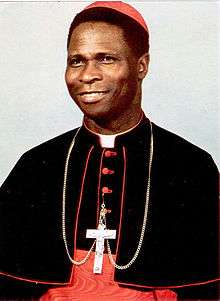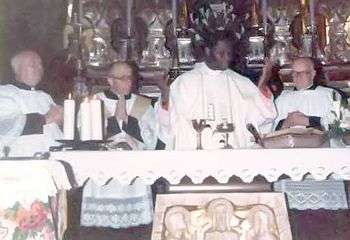Bernardin Gantin
| His Eminence Bernardin Cardinal Gantin | |
|---|---|
| Prefect Emeritus of the Congregation for Bishops | |
 A photo of Cardinal Gantin taken sometime in the early years of his cardinalate | |
| See | Palestrina (suburbicarian) |
| Installed | 8 April 1984 |
| Term ended | 25 June 1998 |
| Predecessor | Sebastiano Baggio |
| Successor | Lucas Moreira Neves |
| Other posts |
Dean of the College of Cardinals (1993–2002) President of the Pontifical Council for Justice and Peace (1976–84) Archbishop of Cotonou (1960–71) |
| Orders | |
| Ordination |
14 January 1951 by Louis Parisot |
| Consecration |
3 February 1957 by Eugène Tisserant |
| Created Cardinal |
27 June 1977 by Pope Paul VI |
| Personal details | |
| Born |
8 May 1922 Toffo, Benin |
| Died |
13 May 2008 (aged 86) Paris, France |
| Coat of arms |
 |
| Styles of Bernardin Gantin | |
|---|---|
 | |
| Reference style | His Eminence |
| Spoken style | Your Eminence |
| Informal style | Cardinal |
| See | Palestrina (suburbicarian) |
Bernardin Gantin (8 May 1922 – 13 May 2008) was a prominent Beninese cardinal of the Roman Catholic Church. He served as Metropolitan Archbishop of the Roman Catholic Archdiocese of Cotonou and then at the Vatican in the service of the Holy See as President of the Pontifical Council for Justice and Peace and then as Prefect of the Sacred Congregation for Bishops. Ultimately, he served as Dean of the Sacred College of Cardinals, a post his French consecrator as a bishop once held and the same position Joseph Ratzinger had after Gantin and before his election as Pope Benedict XVI. He was the highest ranking Catholic to come from Africa since ancient times, when some Popes were believed to have come from there. He enjoyed a close relationship with Pope John XXIII, Popes Paul VI and John Paul I, and most especially, with Pope John Paul II and his fellow curial cardinal and future Pope, Joseph Ratzinger. Like many senior African prelates of his era, he was relatively conservative, but was esteemed by both his native land and for his work in Rome. His tomb in Ouidah, which is frequently visited, was visited personally by Pope Benedict during the Papal Visit to Benin. In May 2013, Vatican officials inaugurated a Chair about "Socializing Policy in Africa" bearing his name at the Pontifical Lateran University.[1]
Early life and ordination
Born in Toffo, Benin, his name means "tree of iron" (gan, iron and tin, tree ), which explains his coat of arms. He entered the minor seminary at age 14 in Benin, and was ordained to the priesthood in 1951 under Archbishop Louis Parisot, who was then the Archbishop of Cotonou. In 1953 he was sent to Rome to study Theology and Canon Law.
Bishop
He was consecrated as Titular Bishop of Tipasa, in Mauritania, and as Auxiliary Bishop of Cotonou in 1957 by Cardinal Eugène-Gabriel-Gervais-Laurent Tisserant, to whose then post of Dean of the Sacred College of Cardinals he would one day succeed.
Archbishop
In 1960, Pope John XXIII appointed him Archbishop of Cotonou. After he attended the Second Vatican Council, Pope Paul VI appointed him to the Roman Curia and made him a Cardinal-Deacon of Sacro Cuore di Cristo Re in Pope Paul's final consistory in 1977. He was named President of the Pontifical Council Cor Unum by Pope John Paul I, the only administrative appointment of that month-long papacy. During the Conclave following John Paul I's death, Cardinal Gantin was thought to be one of the papabili, those cardinals who are considered favorites to be elected pope.
Congregation for Bishops
Under Pope John Paul II he headed the Congregation for Bishops, supervising episcopal appointments in the non-missionary Latin Rite dioceses throughout the world, from 1984 to 1998. He was appointed as Cardinal-Bishop of the suburbicarian diocese of Palestrina in 1986, and as Dean of the College of Cardinals had the additional title of Cardinal-Bishop of Ostia, as the dean traditionally does, from 1993 to 2002 when he retired to move home to Benin (He relinquished the title of the Ostia see when he retired.). He was the first and so far the only non-European Cardinal ever to hold that position. Because he turned 80 on 8 May 2002, Cardinal Gantin was not eligible to vote in the 2005 Papal Election.
Death and mourning
Gantin died in Paris on 13 May 2008, five days after his 86th birthday.[2] The Beninese government declared three days of mourning for him, beginning on 14 May.[3]

Following his death, a telegram was sent by Pope Benedict XVI to Marcel Honorat Léon Agboton, the current Archbishop of Cotonou, after the death of Gantin was announced. The telegram described Gantin as "an eminent son of Benin and Africa who won great respect within the universal Church". The Pope wrote "I ask God the Father, from Whom all mercy comes, to welcome into His light and peace this eminent son of Benin and of Africa who, universally esteemed, was animated by a profound apostolic spirit and by an exalted sense of the Church and her mission in the world."[4]
See also
References
- ↑ Press release (23 May 2013). "Creation of the Cardinal Bernardin Gantin Chair by the Pontifical Lateran University - Vatican City" Archived 7 June 2013 at the Wayback Machine.. Vatican News bulletin, vatican.va. Accessed 23 June 2013.
- ↑ Cardinal Bernardin Gantin, Africa's leading cardinal, has died; The Times, 14 May 2008
- ↑ "Benin starts three-day national mourning for late Cardinal Gantin" Archived 18 May 2008 at the Wayback Machine., African Press Agency, 14 May 2008.
- ↑ "Pope Mourns 'Africa's Eminent Son', Cardinal Gantin". Africanmeeting.net. 16 May 2008. Retrieved 21 December 2008.
External links
| Wikimedia Commons has media related to Bernardin Gantin. |
| Catholic Church titles | ||
|---|---|---|
| Preceded by Louis Parisot |
Archbishop of Cotonou 5 January 1960 – 28 June 1971 |
Succeeded by Christophe Adimou |
| Preceded by Agnelo Rossi |
Dean of the College of Cardinals 5 June 1993 – 30 November 2002 |
Succeeded by Joseph Ratzinger |
| Preceded by Sebastiano Baggio |
Prefect of the Congregation for Bishops 8 April 1984 – 25 June 1998 |
Succeeded by Lucas Moreira Neves |
